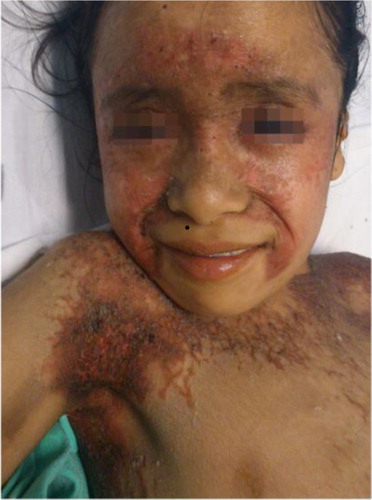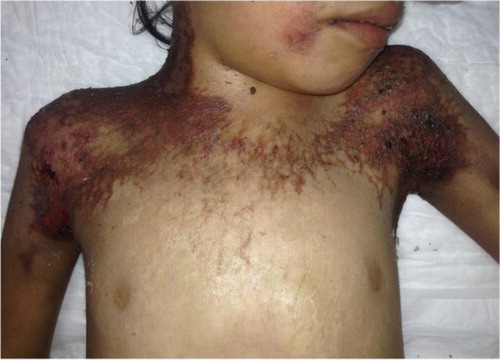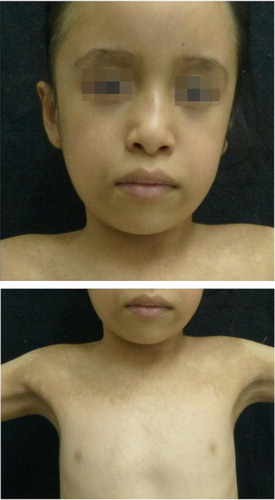Abstract
Pellagra is a nutritional disorder secondary to niacin deficiency. The classical triad is dermatitis, diarrhea, and dementia. We report the case of a young girl with hypermobility-type Ehlers–Danlos syndrome who exhibited the classical pellagra symptoms, despite apparent adequate nutritional intake. Her condition resolved after oral niacin supplements were administered. Although this association has not previously been recognized, an inherited connective tissue disorder may be related to the appearance of pellagra.
A7-year-old girl from a rural area located in San Luis Potosí, México, who exhibited normal food intake, occasionally loose stools and who had been diagnosed with hypermobility-type Ehlers–Danlos syndrome 4 years before. She presented with a 1-month history of occasional itching; symmetrical dermatosis located on the face, neck, anterior upper thorax; and external genitalia. The dermatosis was characterized by hyperkeratotic, hyperpigmented, and erythematous plaques ( and ). The patient manifested more than 10 diarrheic evacuations per day, daily episodes of 39°C fever, hallucinations, and seizures; thus, her rural health center referred her to our hospital. On physical examination, her stature and weight were inappropriately low for her age (5th percentile), and she presented generalized weakness that was more evident in the upper and lower extremities. Her blood test revealed a normocytic normochromic anemia with 5.5 g/dl of hemoglobin. Serum electrolytes and renal function tests were normal, and stool tests were negative to parasites. Electroencephalogram revealed generalized dysfunction during physiological sleep. Pellagra was diagnosed based on the classical triad of dermatitis, diarrhea, and neurologic findings supported by low niacin serum levels below 0.5 ng per milliliter. The patient was treated with a multivitamin intravenous supplement that included nicotinamide 10 mg every 6 hours, blood transfusions, and emollient ointment. The patient showed dermatologic, neurological, and gastrointestinal improvement and was discharged 5 days later with oral niacin supplements. The patient was followed up at 3 and 5 months, and showed progressive improvement of the dermatosis ().
Fig. 1 Cutaneous manifestations of pellagra. Thickened, scaly, and hyperpigmented skin on the photoexposed areas of the face in a girl with Ehlers–Danlos disease.

Fig. 2 Cutaneous manifestations of pellagra. Symmetrical and bilateral hyperkeratotic skin in a parchment like appearance affecting neck and thorax. There are erosions and blackish crusts resulting from hemorrhages.

Fig. 3 Clinical appearance following treatment. Notorious improvement of dermatosis after 3 months of oral intake of 20 mg per day of nicotinamide.

Ehlers–Danlos syndrome is a group of inherited connective tissue disorders caused by a defect in the synthesis of collagen and characterized by mucocutaneous, articular, and systemic manifestations (Citation1); the latter includes a wide spectrum of gut motility disorders (Citation1). The intestinal disorders probably share an unknown pathophysiological connective tissue defect along with the articular manifestations (Citation1). Although Ehlers–Danlos patients may present with diarrhea (Citation1), it had not been previously reported that these episodes interfere with niacin absorption and consequently result in pellagra, which reflects a late stage of a severe cellular deficiency in this vitamin (Citation2). We hypothesized that the Ehlers–Danlos syndrome, the patient's age-related anabolic state, and a probably lower niacin intake may have contributed to this outcome.
Pellagra dermatitis generally exhibits a combination of four presentations (Citation2, Citation3). The most common is a symmetrical and bilateral dermatitis evident on sun-exposed sites. When it appears around the neck, it is called ‘Casal's necklace’. Dermatitis demonstrates an erythematous pruritic rash and edema that becomes rough, cracked, thickened, scaly, and hyperpigmented, resembling a ‘goose skin’. Dermatosis can also be located in the perineum, with erythema and erosions; over bony prominences, with hyperpigmented and thickened plaques; or in the mouth, with angular cheilitis or oral mucositis with erosions or ulcers on the tongue.
Diagnosis of pellagra is clinical; laboratory and histopathology studies are not required (Citation2, Citation3). Treatment should be focused on niacin replacement, but nicotinamide therapy is preferred because it has lower side effects (Citation3). Pellagra has a good prognosis when treated in a timely fashion; if left untreated, however, death will occur within 4 or 5 years, mostly due to infections or neurological causes (Citation2). There are specific nutritional recommendations for Ehlers–Danlos patients, such as profuse fluid intake, electrolytes, antioxidants, coenzymes and cofactors, precursors of cartilage extracellular matrix, and anti-osteopenic supplements (Citation1). We propose that appropriate niacin intake should also be considered.
Conflict of interest and funding
All authors declare no conflicts interest and no financial disclosures.
References
- Castori M. Ehlers-Danlos syndrome, hypermobility type: An underdiagnosed hereditary connective tissue disorder with mucocutaneous, articular, and systemic manifestations. ISRN Dermatol. 2012; 2012: 751–768.
- Hegyi J, Schwartz RA, Hegyi V. Pellagra: Dermatitis, dementia, and diarrhea. Int J Dermatol. 2004; 43: 1–5. [PubMed Abstract].
- Piqué-Duran E, Pérez-Cejudo JA, Cameselle D, Palacios-Llopis S, García-Vázquez O. Pellagra: A clinical, histopathological, and epidemiological study of 7 cases. Actas Dermosifiliogr. 2012; 103: 51–8.
